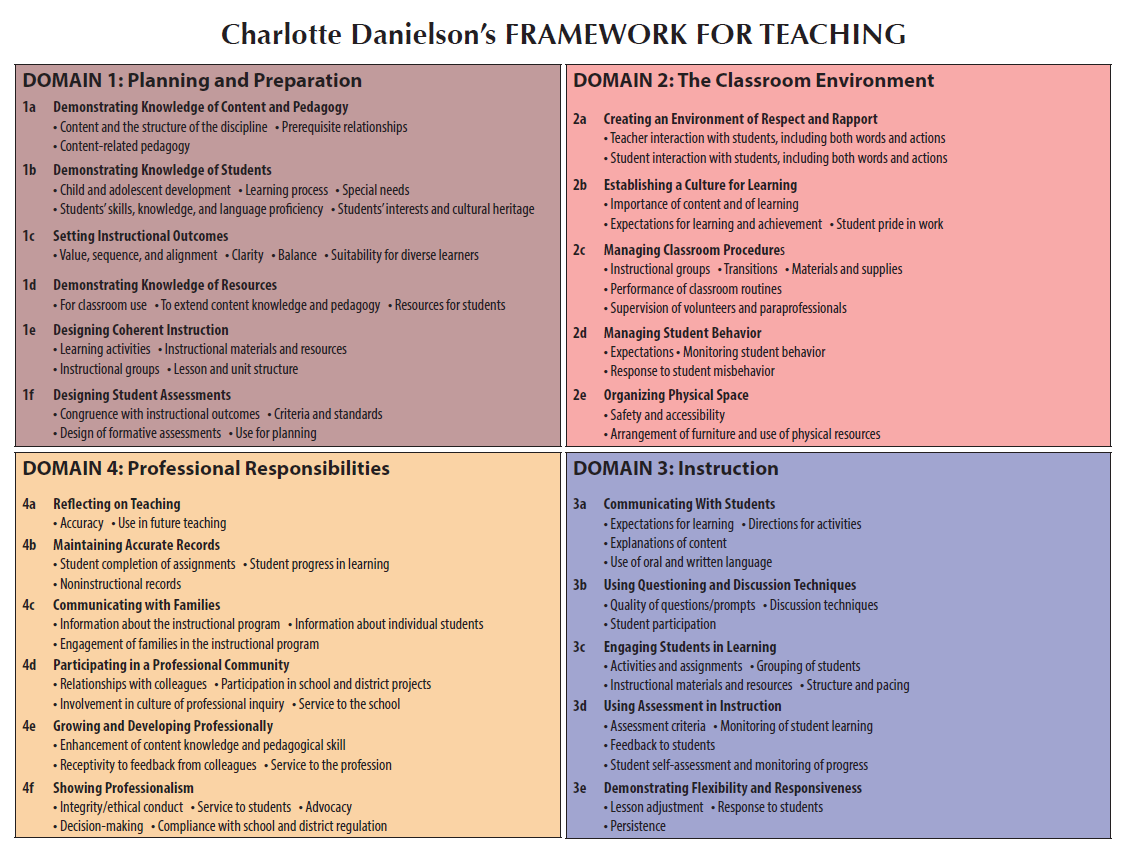
My approach this semester was to review these instructional strategies as they would best demonstrate, in my opinion, the possibility of proficient or distinguished designated with in the components of domains 2 and 3 in Danielson’s Framework. Since our district has adopted the framework for the teacher evaluation process, the various strategies within the instructional model families can be used to strength weaknesses within those components. While only one of the components was attached to each post, it is important to note that each instructional strategy could be used within multiple components. The desired outcome is to enhance the teaching practices, and is not only part of the evaluation, but of professional development, mentoring and coaching. The Danielson Group through research created a concise grouping that they call the Big Six Clusters, establishing these relationships between components within the 4 domains. (“Danielson Group”, 2013)
in the components of domains 2 and 3 in Danielson’s Framework. Since our district has adopted the framework for the teacher evaluation process, the various strategies within the instructional model families can be used to strength weaknesses within those components. While only one of the components was attached to each post, it is important to note that each instructional strategy could be used within multiple components. The desired outcome is to enhance the teaching practices, and is not only part of the evaluation, but of professional development, mentoring and coaching. The Danielson Group through research created a concise grouping that they call the Big Six Clusters, establishing these relationships between components within the 4 domains. (“Danielson Group”, 2013)
When reviewing what types of instructional strategies reflect the best practices within my content area, the information processing models of teaching has the common attributes of instructional strategies used. There also is strong use of the behavioral systems model, which allows for the design of instructional materials and interactions that encourage productive learning taking into account environmental variables that can be controlled.
The first teaching strategy, we reviewed was the use of questioning to allow us to move beyond asking students to remember and involves higher level thinking skills, such as analysis, synthesis or evaluation. To be truly effective, questions should elicit prior knowledge, but also challenge students to think deeper.
One way to scaffold learning using questioning is through Bloom’s taxonomy, we are provided with a set of question stems to help in developing guided opportunities. Dr. Robert Marzano, CEO of Marzano Research Laboratory states that teachers who ask more questions, are more effective and by asking those that require high-order thinking skills, result in an increase in student learning. (Marzano).
Within the Information Processing family is the Inquiry-Training model, where questioning strategies are incorporated to facilitate problem solving and the development of critical thinking. The model has students verifying the relationships between variables, and finally fully explain what happens. Ideally, as students gain experience working with questions, ultimately they will initiate their own questions in response to their own drives for meaning.
While Bruner’s Discovery Learning is a great way to reinforce concepts, it is not for introducing new processes or structures. Learning requires guided instruction, especially for the initial and foundational understanding of new concepts. Problem solving strategies need to be taught, how to identify and fix errors, these strategies are not inherently discoverable. Inquiry Based Learning, is successful since it combines the strategies of Concept Attainment and Discovery Learning.
I believe that my subject area within the educational technology field happens to be highly successful using constructivist teaching strategies. “Students construct knowledge (see Vygotsky, 1986) and teachers facilitate (scaffold) their inquiry. As students learn to develop concepts, the learning of information, concepts, and skills are enhanced” (Page 43). Problem solving strategies need to be taught, how to identify and fix errors, these strategies are not inherently discoverable. In Classroom Instruction that Works, we read that this type of engagement integrated through Cooperative Learning positively affects “both academic and socio-emotional achievement, self-esteem, motivation, and engagement with school” (p.46).
There remain times where guided instruction in conjunction with practice is needed to help students understand the concepts. While Vygostky, and Bruner acknowledged that students must be actively involved in the construction of their own knowledge, scaffolding is an essential in my content area. If a student can explain the application they are likely to be able to use it again successfully When students finally understand the concepts it is an “aha” moment, and that is one of the reasons I love what I do.
Organizers of any kind, whether they are concept maps, flow charts or story maps, ways to assist students to connect foundation knowledge with current and new learning/concepts. They also can ensure students understand how they learn, they can master new learning at any phase of their lives. Ausubel, quoted in Classroom Instruction that Works, says: “The advance organizer model is designed to strengthen students’ cognitive structures—their knowledge of a particular subject at any given time and how well organized, clear, and stable that knowledge is (Ausubel, 1963, p. 27).” (Page 200)
Learning strategies for disabled students, guided by Universal Design for Learning (UDL), which provides a framework for teachers on how they can create curricula that supports the needs of all students. The guidelines of the framework, assist instructors in planning lessons for those students with special needs, by providing assistance on how to create goals, methods, materials and assessments for supporting students with learning challenges.
UDL suggests types of organizers varying by disabilities that are effective in communicating to students what you expect them to learn, in addition to increasing student engagement and interest. The difference between just organizers versus advanced organizers are in the timing of their use and the intent. One benefit to graphic organizers is that they scaffold the learning process and can guide the students.
Constructivism absolutely leads to academic excellence as it requires that students are actively engaged in their own learning. The variation in students’ abilities is what Vygotsky (1978) calls the zone of proximal development: “it is the distance between the actual developmental level as determined by independent problem solving and the level of potential development as determined through problem solving under adult guidance or in collaboration with more capable peers” (p.86).
Constructivism offers an authentic learning experience since the teacher is encouraging the student to identify their own understanding of a concept or problem and “create” their own solutions. They are also learning through experience, “learning by doing”, in addition to connecting their learning to previous knowledge, they are developing a deeper understanding.
Joyce, Weil, & Calhoun remind us in Models in Teaching that the “implementation of democratic methods of teaching has been exceedingly difficult. They require the teacher to have a high level of interpersonal and instructional skills.” The development of the curriculum is purposeful, therefore teachers must differentiate in order to meet the needs of all their students. Students can reach mastery with these aids and can also teach or model for other students.
As educator’s we want our student to show growth in our content areas, and as students and people. Teachers have a direct effect on student’s growth as a person, their self-esteem, and can help or hinder them. Teaching is not entirely content, it’s about learning and how to teach students to learn. Learning is what as modeled, and the environment created reinforces that when students want to be there. A positive, welcoming environment is essential in developing a student’s knowledge in your content area, but most importantly, growth in self-esteem.
An environment of respect and rapport, between teacher and student and student to student are essential in an environment where all students feel they can learn and is directly related to growth in their self-esteem. In Teacher Effects Research on Student Self-Concept, Carl Rogers states “when their teacher relates to them in a person-to-person manner, good things happen”, learning happens.
Mastery Learning is a framework that has resurfaced several times when discussing Career and Technical Education. While Alder felt the vocational course work to be “not the education of free men and women” (Alder), in my opinion, would need to re-evaluate the course work that has replaced vocational education, that of Career and Technical Education. While the course work is to prepare students for the world of work, the reality is that in today’s society careers require more knowledge than can be taught in high school, we are preparing students for post-secondary education. Career course work is defined through a set of objectives that are mastered in order to meet requirements. Certain mastery requirements are that of the class and others, are those of Industry Certifications. While a number of states in the country are relaxing seat-time requirements, Washington State is doing the opposite. (Cavanagh, 2012) In 2014 the seat time requirement for credit in grades 7-12 increased from 1000 to 1080 hours of instruction. Whether or not a student masters the required objectives or not, they are in the same class as other students who require more time. It is essential that we plan and prepare meaningful instruction for them throughout the entire course.
Domains 2 and 3 of the Danielson’s Framework represent what happens in the classroom. The teacher’s skill in these domains is demonstrated in the classroom. Through the classroom environment: Creating an Environment of Respect and Rapport, Establishing a Culture for Learning, Managing Classroom Procedures, and Managing Student Behavior. Through instruction: Communicating with Students, Using Questioning and Discussion Techniques, Engaging Students in Learning, Using Assessment in Instruction, and Demonstrating Flexibility and Responsiveness. All of the instructional model families and the instructional strategies meet these components of what we work toward, that of good teaching. (“Danielson Group : The Framework,” 2013)
Adler, M. J. (n.d.) The Paideia Proposal: An Educational Manifesto Handout from EDU 6526, Seattle Pacific University, May 25, 2015.
Cavanagh, S. (2012, March 7). States Loosening ‘Seat Time’ Requirements – Education Week. Retrieved from http://www.edweek.org/ew/articles/2012/03/07/23biz-state.h31.html
Danielson Group » The Framework. (2013). Retrieved from https://danielsongroup.org/framework/
Dean, C. (2012). Classroom instruction that works research-based strategies for increasing student achievement (2nded.). Alexandria, Va.: ASCD.
Dean, Ceri B.; Hubbell, Elizabeth Ross; Pitler, Howard; Stone, Bj (2012-01-05). Classroom Instruction That Works: Research-Based Strategies for Increasing Student Achievement, 2nd. Association for Supervision & Curriculum Development.
Developing Questions for Critical Thinking. (2009, January 1). Retrieved April 9, 2015, from http://farr-integratingit.net/Theory/CriticalThinking/revisedcog.htm
Dewey, J. (1897). My Pedagogic Creed. The School Journal
Joyce, Bruce R.; Weil, Marsha; Calhoun, Emily (2014-06-05). Models of Teaching (9th Edition). Pearson.
Marzano, R. (n.d.). 9. Cues, Questions, and Advance Organizers. Retrieved April 9, 2015, from http://escmarzano.wikispaces.com/9. Cues, Questions, and Advance Organizers
Meyer, A., & Rose, D. (2014). Universal design for learning: Theory and practice. Cast Incorporated.
New: Bloom’s Taxonomy Planning Kit for Teachers. (2014, March 28). Retrieved April 9, 2015, from http://www.educatorstechnology.com/2014/03/new-blooms-taxonomy-planning-kit-for.html
Reasoner, R. (2010). NASE – National Association for Self Esteem: What is Self-Esteem?. Retrieved from http://www.self-esteem-nase.org/what.php
Rogers, C. (n.d.). Teacher effects research on student self concept. Handout from EDU 6526, Seattle Pacific University, May 22, 2015.
The Academy of Inquiry Based Learning. (n.d.). Retrieved April 17, 2015, fromhttp://www.inquirybasedlearning.org/
The IBL Blog. (n.d.). Retrieved April 17, 2015, from http://theiblblog.blogspot.com/
The Urban Collaborative. (n.d.). Retrieved April 26, 2015, fromhttps://www.urbancollaborative.org/
Using Effective Questions. (2014, July 16). Retrieved April 9, 2015, fromhttp://www.cte.cornell.edu/teaching ideas/engaging-students/using-effective-questions.html
Vygotsky, L.S. (1978). Mind in Society: The Development of Higher Psychological Processes. Cambridge, Massachusetts: Harvard University Press
